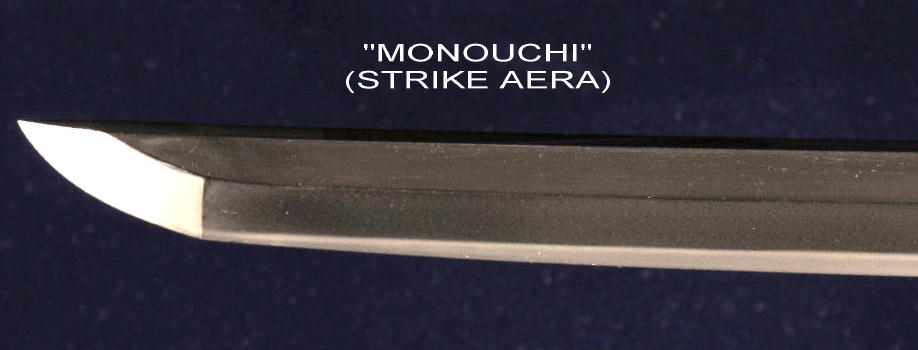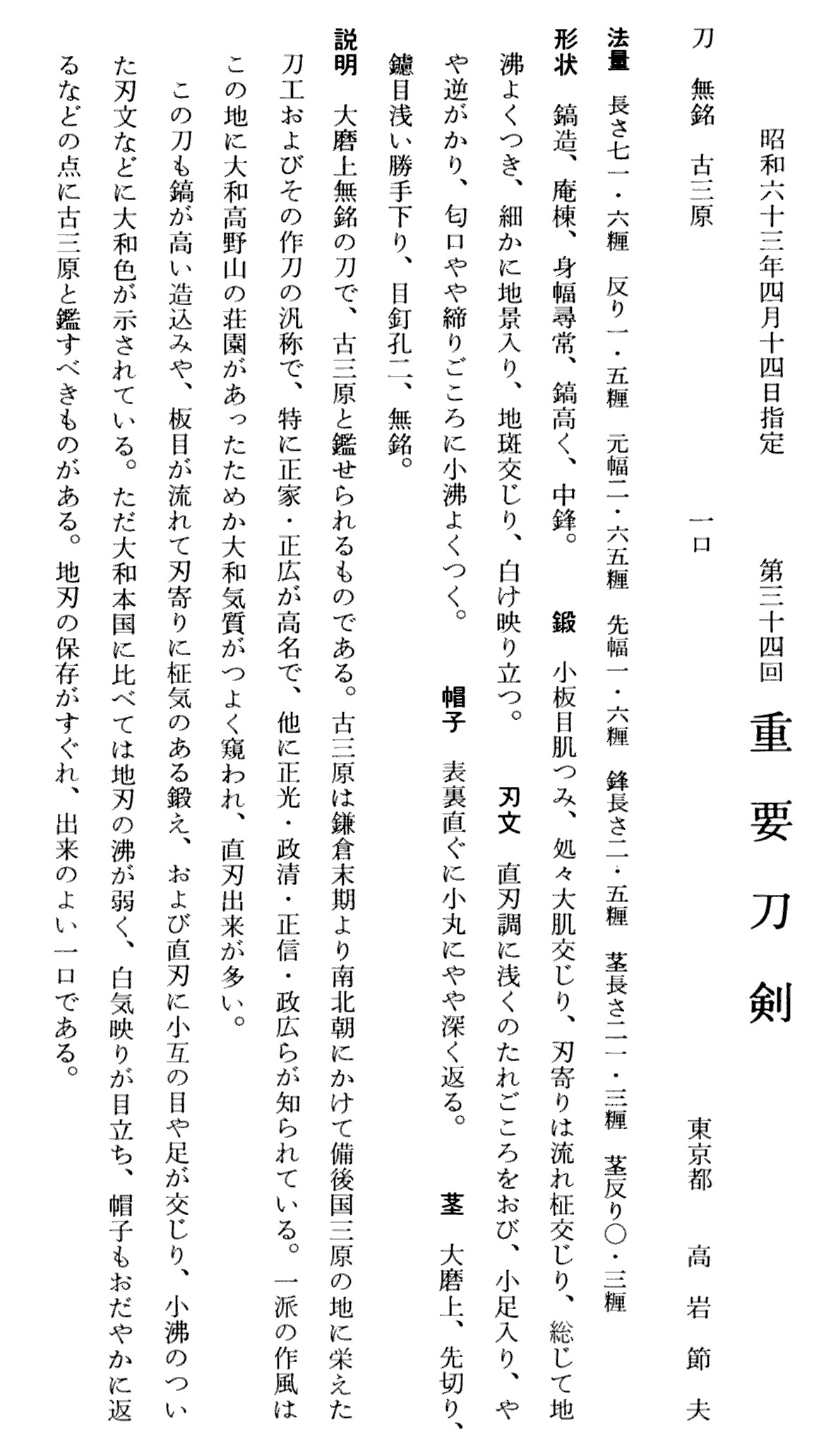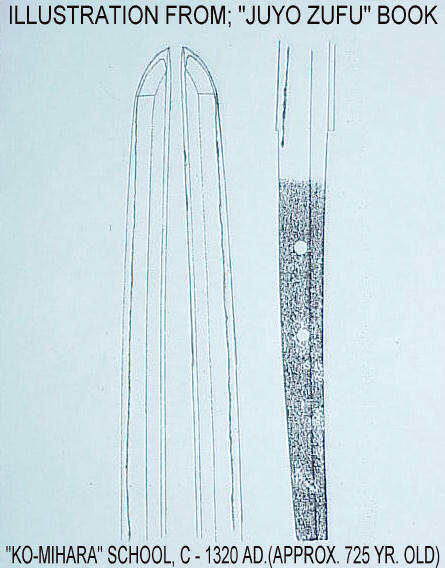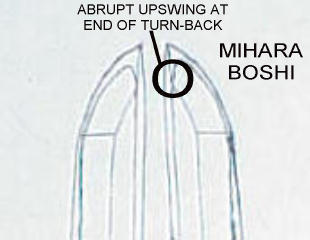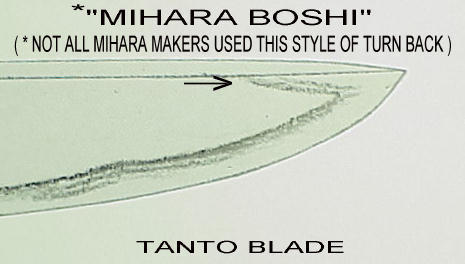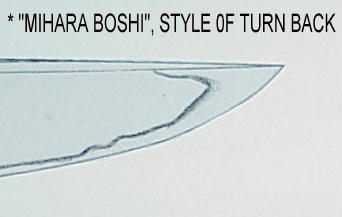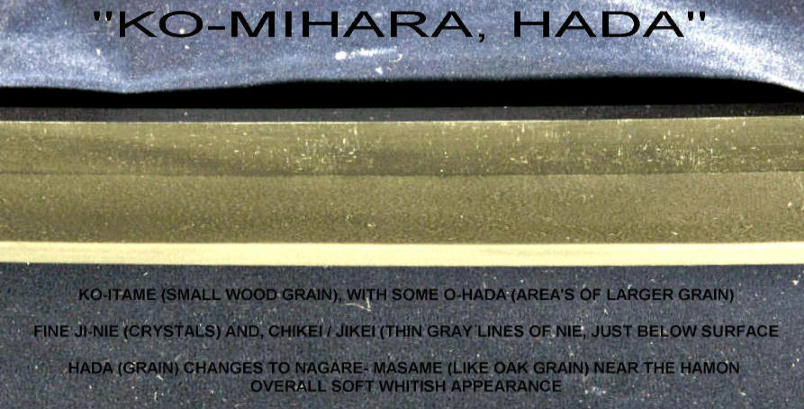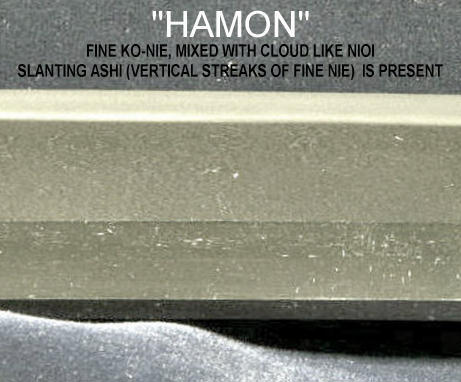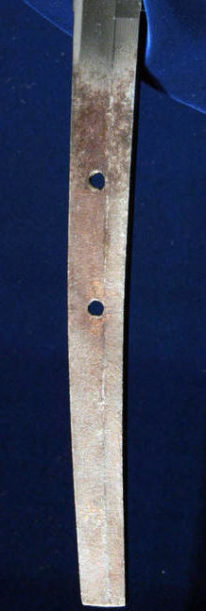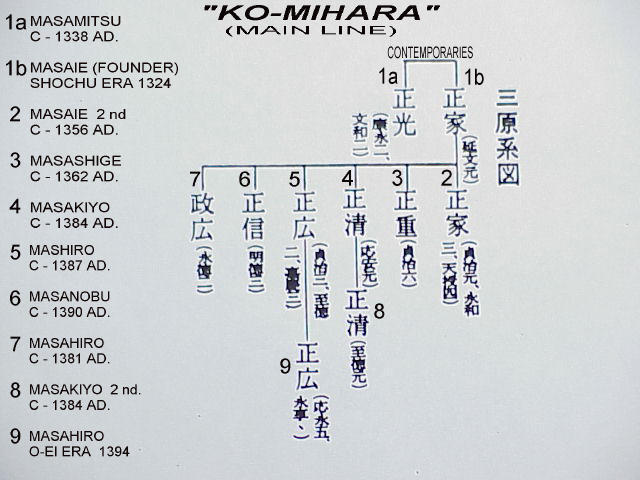Gallery Page (Display Only)
Ko-Mihara School
Bingo Prov.
C-1306-1356 AD
Juyo token by the NBTHK
THE KO-MIHARA SCHOOL WAS FOUNDED BY MASAIE DURING THE KAMAKURA PERIOD FROM TOKUJI (1306 TO SHO-CHU 1334 AD. BLADES OF THE EARLY KO-MIHARA SCHOOL ARE FOR THE MOST PART “O-SURIAGE”. THIS IS DUE TO THERE GREAT LENGTH THAT GAVE THE MOUNTED WARRIOR A DISTINCT ADVANTAGE. MASAIE AND MASAMITSU WERE SUCCEEDED BY, MASAHIRO DURING THE NAMBOKUCHO PERIOD. WORKS BY KO-MIHARA HAVE STRONG YAMATO INFLUENCE, AND OCCASIONALLY BIZEN INFLUENCE. IT IS THOUGHT THAT MASAIE SPENT SOME TIME STUDYING WITH THE MASTERS OF BIZEN, ON HIS WAY TO BINGO (BINGO PROVINCE IS SYNONYMOUS WITH THE MIHARA SCHOOL). MASAIE’S MOST PROLIFIC PERIOD IS THOUGHT TO BE THE KEM-MU ERA (1334). IT IS VERY RARE TO SEE ANY WORKS FROM MASAIE OR MASAHIRO, AND ARE ONLY A FEW THAT ARE DATED. ALL OF THE MAIN LINE MIHARA SMITHS SIGNED WITH MASA; (MASAKIYO, MASAMITSU, MASANOBU). IN ADDITION TO THE MAIN LINE THERE WAS THE “HOKKE ICHIJO”, AND SHIMBO MIHARA GROUPS. DURING THE LATER NAMBOKUCHO PERIOD SEVERAL ADDITIONAL MIHARA GROUPS, SUCH AS ASHIDA, TOMO, KINASHI, SHIMBO HOKKE, AND KAI. THESE LATER GROUPS ALSO HAVE YAMATO INFLUENCE.
THE WORKMANSHIP (KITAE) OF MIHARA BLADES HAVE HIGH, AND WIDE SHINOGI-JI, HADA WITH DENSE KO-ITAME SOMETIMES WITH MASAME, WHITISH JIGANE, AND HAMON STYLES OF SUGUBA SOMETIMES WITH MIXED MIDARE, ASHI, INAZUMA AND SUNAGASHI. THE MOST EASILY NOTICED DISTINGUISHING FACTOR, IS THE “MIHARA BOSHI”. THESE ARE THE MOST NOTICEABLE.
THE TYPICAL “MIHARA BOSHI”: THESE BOSHI’S HAVE A RATHER SOFT KO-MARU (SMALL ROUND) TURN BACK, WITH A RATHER ABRUPT TURNED UP (TOWARD THE MUNE) ENDING (SEE DRAWING). HORIMONO IS VERY RARE. KO-MIHARA BLADES ARE RATED “OWAZAMONO” (SUPREME SHARPNESS)!
THERE IS A FAMOUS TACHI NAMED “O-MIHARA” THAT TOYOTOMI HIDEYOSHI, (PERSONAL ASSISTANT TO DAIMYO ODA NOBUNAGA) GAVE AS A GIFT TO ASANO YUKINAGA, A FAMOUS TOYOTOMI RETAINER. AS FOR THE TIMELINE OF THIS SCHOOL, KO-MIHARA REFERS TO THE EARLY WORKS (LATTER PART OF KAMAKURA), CHU-MIHARA TO THOSE OF NAMBOKUCHO, AND SUE-MIHARA TO THOSE AFTER O-EI (1394) AND DURING THE MUROMACHI PERIOD.
THE EXTREME SHARPNESS, AND DURABILITY OF THE MIHARA BLADES WAS RESPONSIBLE FOR THERE POPULARITY. IT IS COMMON AMONG SWORD JUDGES TO CALL A BLADE WITH YAMATO INFLUENCE THAT THEY ARE UNCERTAIN OF, “MIHARA”. EARLY KO-MIHARA BLADES, SUCH AS THIS JUYO EXAMPLE EXHIBITING KAMAKURA STYLE, YAMATO INFLUENCE, AND THE “MIHARA BOSHI” (NOT ALWAYS PRESENT), ARE VERY DESIRABLE.
Jūyō-tōken at the 34th jūyō shinsa held on April 14, 1988
katana, mumei: Ko-Mihara (古三原)
Tōkyō, Takaiwa Setsuo (高岩節夫)
Measurements
nagasa 66.95 cm, sori 2.0 cm, motohaba 2.6 cm, sakihaba 1.8 cm, kissaki-nagasa 2.3 cm, nakago-nagasa 24.3 cm, nakago-sori 0.2 cm
Description
Keijō: shinogi-zukuri, iori-mune, normal mihaba, high shinogi, chū-kissaki
Kitae: dense ko-itame that is mixed with some ō-hada and nagare-masame towards the ha and that features plenty of ji-nie all over the blade, fine chikei, jifu, and a shirake-utsuri
Hamon: ko-nie-laden suguha-chō with a rather tight nioiguchi that tends to a gently undulating notare and that is mixed with ko-ashi which tend to slant
Bōshi: sugu with a relatively wide ko-maru-kaeri
Nakago: ō-suriage, kirijiri, gently slanting katte-sagari yasurime, two mekugi-ana, mumei
Explanation
This is an ō-suriage mumei katana that can be attributed to Ko-Mihara (古三原). Ko-Mihara (lit. “early Mihara”) is an umbrella term for the swordsmiths who flourished from the end of the Kamakura to the Nanbokuchō period in Mihara in Bingo province and their works. Most famous of this group are Masaie (正家) and Masahiro (正広), but we also know, e.g., the names of the Ko-Mihara smiths Masamitsu (正光), Masakiyo (政清), Masanobu (正信), and Masahiro (政広). As the local Kōyasan (高野山) manor was owned by facilities based in Yamato province, Mihara works prominently display characteristics of the Yamato tradition and are mostly hardened in suguha.
With its high shinogi, the itame being mixed with nagare and with masame towards the ha, and the suguha in nie-deki that is mixed with ko-gunome and ashi, this blade does feature Yamato characteristics as well. Compared to works produced in Yamato province, however, the nie of ji and ha are not as emphasized, a shirake-utsuri appears, and the bōshi has a more lenient kaeri, all typical characteristics which attribute the blade to Ko-Mihara. The jiba is in excellent condition and the deki is excellent as well.
This Sword is not available for purchase.
If you wish to purchase a Japanese Sword, please view our Nihonto for sale page or contact us directly via email or by telephone at 1(608) 315-0083 any time. Please include specifics of what you seek, i.e.: Katana, maker, era, price range, etc.
Pictures and content may not be copied without the express permission of samuraisword.com ©





